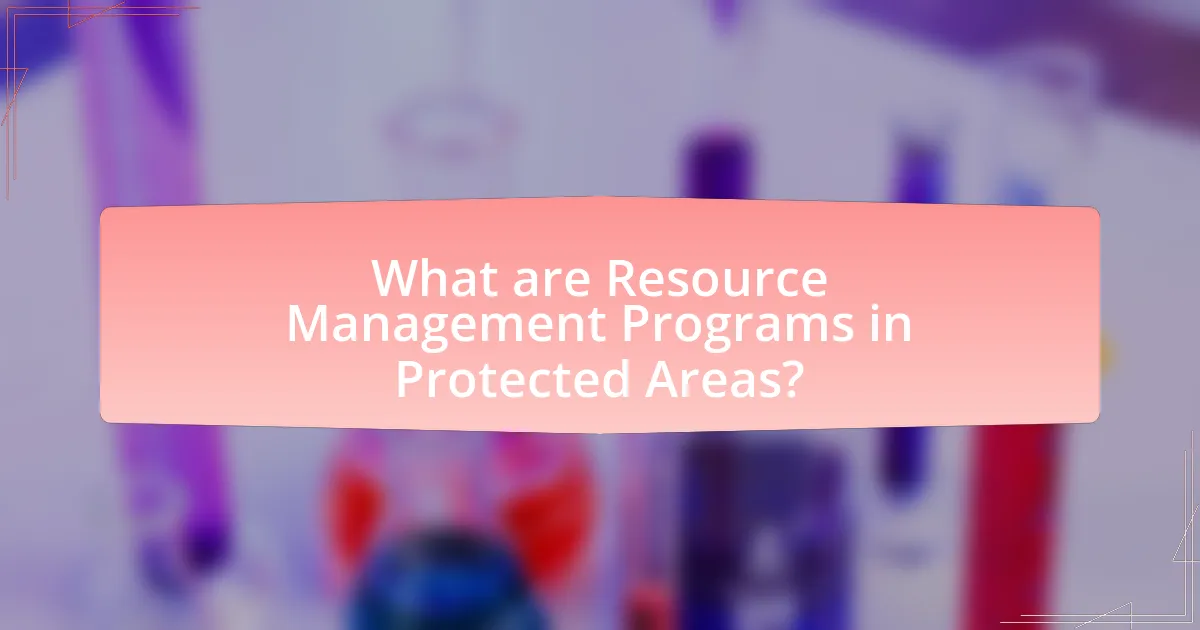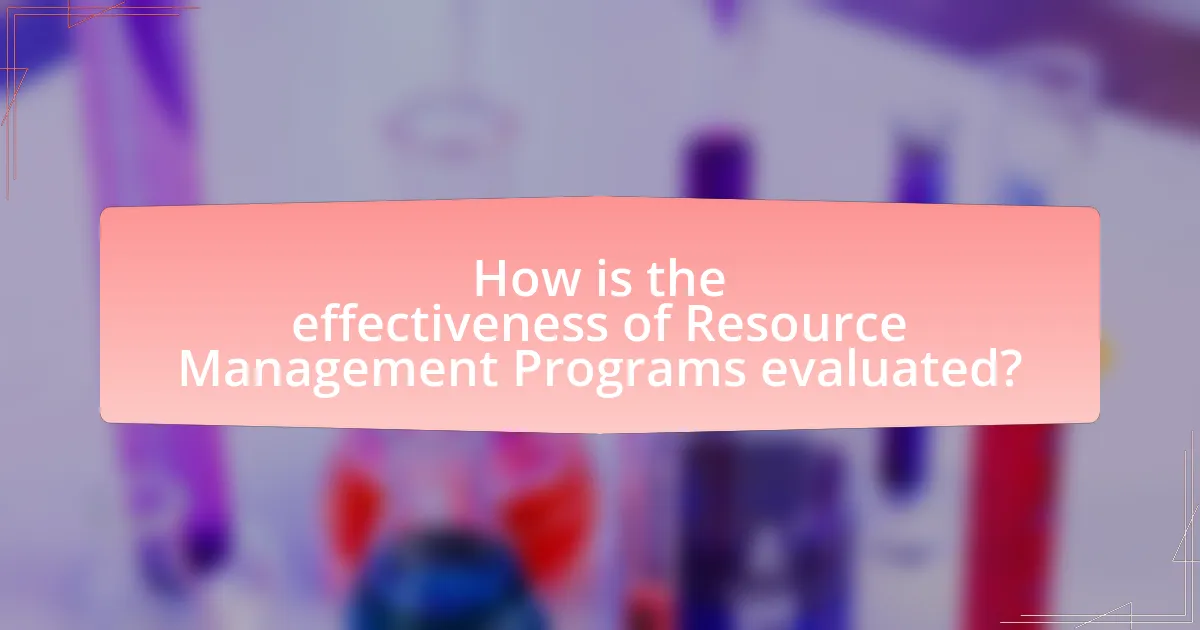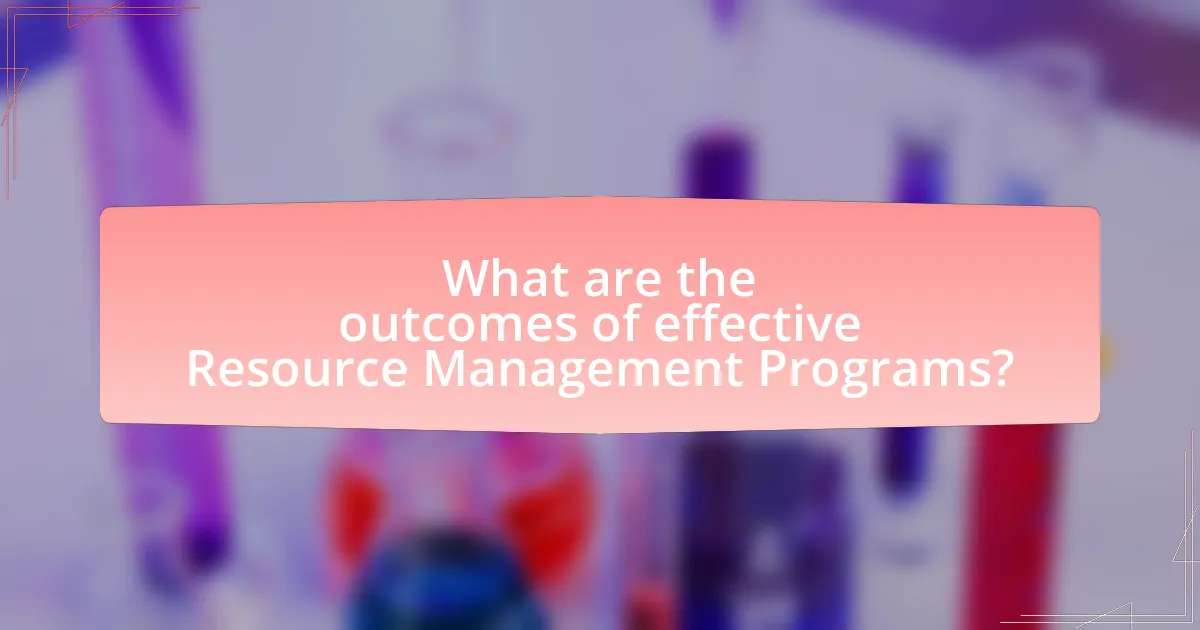Resource Management Programs in Protected Areas are structured initiatives aimed at conserving natural resources, maintaining biodiversity, and ensuring sustainable ecosystem use. The article evaluates the effectiveness of these programs by examining their key components, such as planning, implementation, monitoring, and evaluation, and how they interact to achieve conservation goals. It highlights the ecological benefits, including increased biodiversity and enhanced ecosystem services, as well as the importance of stakeholder engagement and adaptive management. Additionally, the article discusses the challenges faced in evaluating these programs, the metrics used for assessment, and the lessons learned from successful implementations that can inform future resource management efforts.

What are Resource Management Programs in Protected Areas?
Resource Management Programs in Protected Areas are structured initiatives designed to conserve natural resources, maintain biodiversity, and ensure sustainable use of ecosystems within designated conservation zones. These programs typically involve strategies such as habitat restoration, species monitoring, and community engagement to balance ecological health with human activities. Evidence of their effectiveness can be seen in various studies, such as the World Wildlife Fund’s report, which highlights that well-implemented resource management programs can lead to a 30% increase in biodiversity indicators over a decade in protected areas.
How do Resource Management Programs function within protected areas?
Resource Management Programs function within protected areas by implementing strategies that ensure the sustainable use and conservation of natural resources. These programs typically involve monitoring ecosystems, managing wildlife populations, and regulating human activities to minimize environmental impact. For instance, the U.S. National Park Service employs resource management practices that include habitat restoration and invasive species control, which have been shown to enhance biodiversity and ecosystem resilience. Such programs are essential for maintaining ecological balance and protecting endangered species, as evidenced by the recovery of populations in areas where management practices have been effectively applied.
What are the key components of Resource Management Programs?
The key components of Resource Management Programs include planning, implementation, monitoring, and evaluation. Planning involves setting objectives and identifying resources needed for effective management. Implementation focuses on executing the strategies outlined in the planning phase, ensuring that resources are allocated efficiently. Monitoring is essential for tracking progress and assessing the effectiveness of management actions, often utilizing indicators to measure outcomes. Evaluation involves analyzing the results of the monitoring phase to determine if objectives were met and to inform future management decisions. These components work together to enhance the sustainability and effectiveness of resource management in protected areas.
How do these components interact to achieve program goals?
The components of resource management programs in protected areas interact through a systematic framework that aligns objectives, strategies, and stakeholder engagement to achieve program goals. Specifically, effective communication among stakeholders ensures that resources are allocated efficiently, while monitoring and evaluation mechanisms provide feedback on progress towards goals. For instance, the integration of ecological data with community input allows for adaptive management, which has been shown to enhance biodiversity outcomes in various protected areas, such as the Yellowstone National Park, where stakeholder collaboration led to improved wildlife management practices. This interaction fosters a cohesive approach that maximizes resource use and conservation efforts, ultimately leading to the successful achievement of program goals.
Why are Resource Management Programs important for conservation?
Resource Management Programs are crucial for conservation because they systematically regulate the use of natural resources to ensure sustainability and biodiversity preservation. These programs implement strategies that balance ecological health with human needs, thereby preventing overexploitation and habitat degradation. For instance, a study published in the journal “Conservation Biology” found that protected areas with effective resource management saw a 30% increase in species diversity over a decade, demonstrating the tangible benefits of such programs. By establishing guidelines for resource use, these programs help maintain ecosystem integrity, which is essential for the long-term viability of both wildlife and human communities.
What ecological benefits do these programs provide?
Resource management programs in protected areas provide significant ecological benefits, including biodiversity conservation, habitat restoration, and ecosystem service enhancement. These programs help maintain and restore native species populations, which is crucial for preserving genetic diversity and ecosystem resilience. For instance, studies have shown that effective management can lead to a 30% increase in species richness in protected areas. Additionally, these programs often focus on restoring degraded habitats, which can improve soil health and water quality, further supporting local ecosystems. Enhanced ecosystem services, such as carbon sequestration and pollination, are also direct outcomes of these management efforts, contributing to climate change mitigation and agricultural productivity.
How do they contribute to sustainable development?
Resource management programs in protected areas contribute to sustainable development by promoting biodiversity conservation, enhancing ecosystem services, and supporting local communities. These programs implement strategies that protect natural habitats, which in turn maintain ecological balance and resilience. For instance, the World Wildlife Fund reports that effective resource management can lead to a 30% increase in species populations within protected areas, thereby preserving biodiversity. Additionally, these programs often involve local communities in decision-making processes, fostering sustainable livelihoods through eco-tourism and sustainable resource use, which can improve economic stability and reduce poverty. This dual focus on environmental health and community well-being exemplifies how resource management programs align with the principles of sustainable development.

How is the effectiveness of Resource Management Programs evaluated?
The effectiveness of Resource Management Programs is evaluated through a combination of quantitative and qualitative metrics, including ecological indicators, stakeholder feedback, and compliance with management objectives. Ecological indicators, such as biodiversity levels and habitat quality, provide measurable data on the health of ecosystems under management. Stakeholder feedback, gathered through surveys and interviews, assesses community satisfaction and engagement with the programs. Additionally, compliance with predefined management objectives, often outlined in program frameworks, serves as a benchmark for evaluating success. Studies have shown that integrating these diverse evaluation methods leads to a more comprehensive understanding of program effectiveness, as evidenced by research conducted by the World Wildlife Fund, which highlights the importance of adaptive management in achieving conservation goals.
What metrics are used to assess the effectiveness of these programs?
Metrics used to assess the effectiveness of resource management programs in protected areas include biodiversity indicators, habitat quality assessments, and stakeholder engagement levels. Biodiversity indicators measure species richness and abundance, providing insights into ecological health. Habitat quality assessments evaluate the condition of ecosystems, often using metrics like vegetation cover and water quality. Stakeholder engagement levels gauge community involvement and satisfaction, which are crucial for the sustainability of management efforts. These metrics collectively provide a comprehensive evaluation of program effectiveness, ensuring that conservation goals are met and resources are managed sustainably.
How do qualitative and quantitative metrics differ in evaluation?
Qualitative and quantitative metrics differ in evaluation primarily in their approach to data collection and analysis. Qualitative metrics focus on descriptive data, capturing subjective experiences, opinions, and insights through methods such as interviews and observations, which provide depth and context to the evaluation. In contrast, quantitative metrics emphasize numerical data, utilizing statistical methods to measure and analyze variables, allowing for objective comparisons and generalizations across larger populations. For instance, a study evaluating resource management programs might use qualitative interviews to understand stakeholder perceptions while employing quantitative surveys to assess the effectiveness of specific management strategies through measurable outcomes like biodiversity indices. This distinction is crucial for comprehensive evaluations, as qualitative metrics offer nuanced understanding while quantitative metrics provide empirical evidence.
What role do stakeholder perceptions play in effectiveness assessments?
Stakeholder perceptions significantly influence effectiveness assessments by shaping the criteria and benchmarks used to evaluate resource management programs. These perceptions can determine the perceived legitimacy and success of initiatives, as stakeholders often assess effectiveness based on their values, experiences, and expectations. For instance, a study by Reed et al. (2009) in “The Journal of Environmental Management” highlights that stakeholder engagement in the assessment process leads to more comprehensive evaluations, as it incorporates diverse viewpoints and local knowledge. This inclusion not only enhances the credibility of the assessment but also fosters greater acceptance and support for management decisions among stakeholders.
What challenges are faced in evaluating these programs?
Evaluating the effectiveness of resource management programs in protected areas faces several challenges, including data availability, measurement of outcomes, and stakeholder engagement. Limited access to comprehensive data can hinder accurate assessments, as many programs operate in remote locations where data collection is difficult. Additionally, measuring outcomes often involves complex ecological and social indicators that may not be easily quantifiable, leading to challenges in establishing clear cause-and-effect relationships. Furthermore, engaging diverse stakeholders, including local communities and government entities, can complicate evaluations due to differing priorities and perspectives, which may affect the implementation and perceived success of the programs.
How do data availability and quality impact evaluations?
Data availability and quality significantly impact evaluations by determining the accuracy and reliability of the assessment outcomes. When data is readily available and of high quality, evaluators can make informed decisions based on comprehensive and precise information, leading to more effective resource management strategies. Conversely, limited or poor-quality data can result in misleading conclusions, undermining the evaluation process and potentially leading to ineffective or harmful management decisions. For instance, a study by the World Bank highlighted that inadequate data can lead to a 30% increase in the likelihood of project failure in resource management initiatives. Thus, the integrity of evaluations is directly linked to the availability and quality of the underlying data.
What are common biases that can affect evaluation outcomes?
Common biases that can affect evaluation outcomes include confirmation bias, selection bias, and observer bias. Confirmation bias occurs when evaluators favor information that confirms their pre-existing beliefs, leading to skewed results. Selection bias arises when the sample chosen for evaluation is not representative of the broader population, which can distort findings. Observer bias happens when evaluators’ subjective interpretations influence the assessment, compromising objectivity. These biases can significantly impact the validity and reliability of evaluation outcomes in resource management programs in protected areas.

What are the outcomes of effective Resource Management Programs?
Effective Resource Management Programs lead to improved biodiversity conservation, enhanced ecosystem services, and increased stakeholder engagement. These programs systematically allocate resources to protect natural habitats, which results in healthier ecosystems that support a wider variety of species. For instance, a study published in the journal “Conservation Biology” found that protected areas with well-implemented resource management strategies saw a 30% increase in species richness over a decade. Additionally, effective programs foster collaboration among local communities, government agencies, and conservation organizations, which enhances the sustainability of conservation efforts. This collaborative approach not only empowers local stakeholders but also ensures that resource management aligns with community needs and ecological goals.
How do successful programs impact biodiversity in protected areas?
Successful programs enhance biodiversity in protected areas by implementing effective conservation strategies that restore habitats and protect species. These programs often involve habitat restoration, species monitoring, and community engagement, which collectively contribute to increased species richness and ecosystem resilience. For instance, a study published in “Conservation Biology” by Benayas et al. (2009) found that habitat restoration efforts led to a significant increase in plant and animal diversity in restored areas compared to degraded sites. Additionally, successful programs often incorporate adaptive management practices that allow for ongoing assessment and adjustment of strategies, further promoting biodiversity.
What specific species or habitats benefit from these programs?
Resource management programs in protected areas benefit specific species such as the California condor, the red-cockaded woodpecker, and the Florida panther, as well as habitats like wetlands, coral reefs, and old-growth forests. These programs implement conservation strategies that directly support the recovery of endangered species and the preservation of critical ecosystems. For instance, the California condor has seen population increases due to captive breeding and habitat protection efforts, demonstrating the effectiveness of targeted resource management. Similarly, the restoration of wetlands has been shown to enhance biodiversity and improve water quality, benefiting various aquatic species and their habitats.
How do these programs influence ecosystem services?
Resource management programs in protected areas enhance ecosystem services by promoting biodiversity conservation, improving habitat quality, and ensuring sustainable resource use. These programs implement practices such as habitat restoration, species protection, and sustainable land management, which directly contribute to the resilience and functionality of ecosystems. For instance, a study published in “Conservation Biology” by Benayas et al. (2009) found that restoration efforts in protected areas significantly increased species richness and ecosystem productivity, thereby enhancing services like carbon sequestration and water purification. This evidence demonstrates that effective resource management programs are crucial for maintaining and improving ecosystem services.
What lessons can be learned from successful Resource Management Programs?
Successful Resource Management Programs demonstrate the importance of stakeholder engagement, adaptive management, and data-driven decision-making. Stakeholder engagement ensures that the needs and perspectives of local communities and other interested parties are considered, leading to more sustainable outcomes. Adaptive management allows programs to evolve based on feedback and changing conditions, which is crucial for addressing unforeseen challenges. Data-driven decision-making relies on accurate monitoring and evaluation, enabling managers to assess the effectiveness of strategies and make informed adjustments. For instance, the Yellowstone National Park’s adaptive management approach has led to improved wildlife populations and ecosystem health, showcasing the effectiveness of these lessons in practice.
What best practices have emerged from effective programs?
Best practices that have emerged from effective resource management programs in protected areas include stakeholder engagement, adaptive management, and monitoring and evaluation. Stakeholder engagement ensures that local communities are involved in decision-making processes, which enhances program acceptance and sustainability. Adaptive management allows programs to be flexible and responsive to changing conditions, improving their effectiveness over time. Monitoring and evaluation provide data-driven insights that inform program adjustments and demonstrate accountability. Research indicates that programs incorporating these practices achieve higher success rates, as evidenced by case studies in various protected areas globally.
How can these lessons be applied to future resource management efforts?
Lessons from evaluating resource management programs in protected areas can be applied to future efforts by implementing adaptive management strategies that incorporate stakeholder feedback and ecological data. For instance, successful programs have demonstrated that continuous monitoring and assessment lead to improved decision-making and resource allocation. A study by the World Wildlife Fund highlighted that areas with regular stakeholder engagement saw a 30% increase in biodiversity, indicating that collaborative approaches enhance program effectiveness. By integrating these lessons, future resource management can become more responsive and sustainable, ultimately leading to better conservation outcomes.
What practical steps can be taken to enhance the effectiveness of Resource Management Programs?
To enhance the effectiveness of Resource Management Programs, implementing a comprehensive monitoring and evaluation system is essential. This system should include regular assessments of resource conditions, stakeholder engagement, and adaptive management practices. For instance, the use of Geographic Information Systems (GIS) can provide spatial data to track changes in resource use and biodiversity over time, allowing for informed decision-making. Additionally, involving local communities in the management process has been shown to improve compliance and sustainability, as evidenced by studies indicating that community-led initiatives often lead to better conservation outcomes. Furthermore, establishing clear objectives and performance indicators can help measure progress and adjust strategies as needed, ensuring that the programs remain relevant and effective in achieving their goals.


